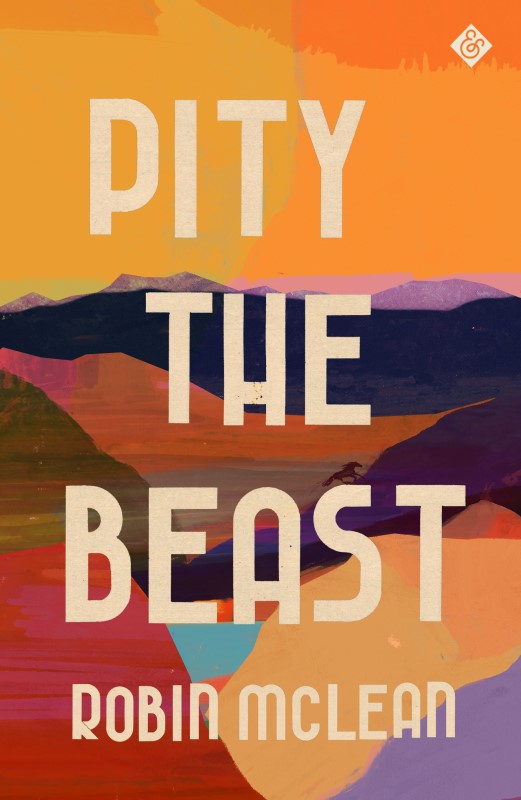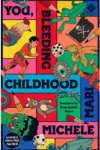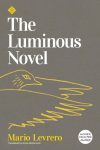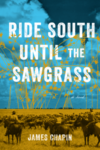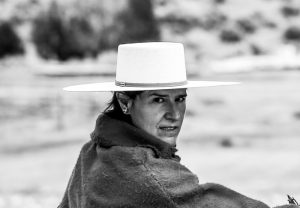
(c) Melissa Guerra
With language as expansive as mountain landscapes, Robin McLean’s Pity the Beast (from And Other Stories) offers us a new take on the Western about survival and revenge, where the mythology of the American West is interrogated at gunpoint. My reading experience was one of horror and awe, as McLean paints the world without leaving out any of the blood: the lengths these characters will go, pursued or in pursuit, to in order to survive, or to prove a point, are as deep and dark as the outer limits of space. Pity the Beast is difficult to look at directly, but will not let you avert or close your eyes.
Kyle Francis Williams: I would love to start by asking you about horses. This book, as a kind of Western, features horses prominently — as mythological figures spanning eons, as necessities of travel, and as characters unto themselves. It would not be unfair to say horses drive the plot. How do you go about crafting nonhuman characters, especially ones that feature so prominently in American mythology? Do you fear anthropomorphizing, or brutalizing?
Robin McLean: I can’t remember the last time I rode a horse but I live among horses now in a very very remote part of the Great Basin where wild horses are the most common animal (besides rabbits and birds) that we see daily. They are our neighbors here.
When I think of making characters, I immediately think of those paper cutout dolls we had when we were kids. Cut out an airline pilot outfit, fold the tabs down over shoulders, arms and legs, and the blank person becomes an airline pilot. Cut out a ballgown and poof, Cinderella. I make characters like this, I guess, attaching very simple objects, actions and gestures to them, like the cut out. I have faith that readers will form full beings from my stripped down methods. I didn’t treat horses (or mules) differently in Pity the Beast, despite their vaulted place in American mythology, or as archetypes. If I call a horse “a cob,” color him in with brown, give him a thick mane and a particular way of trotting, the reader builds the cob for me in their mind. From there, character accrues with action, just as in our lives. This same cob plows without hesitation into a cold, fast flowing river and we know what that means about him. Brave, loyal, trusting. Make another horse a bay and very pretty, pampered by the toughest guy in the group, and character accrues for both horse and horseman as he brushes her down each night at the edge of the fire ring.
As for fear of brutalizing. Well, I do not like the brutalizing, of course. Those parts are very hard to write or read or even think about later. But what I’m trying to do as a human being (a writer) is to depict the world I see and this world we live in is terribly brutal to animals, to humans, to beings of all kinds, isn’t it? Why pussy foot around? And every western I’ve ever read or seen is brutal, at least on some level, though brutality is often relegated to background. The camera turns away. Same with all kinds of narrative we ingest now. If you are watching a James Bond movie, bunches of people are wiped out in the initial sequence car chase. Why not look hard at those wiped out? The entertainment value is lost if you pay close attention to the brutalized. We’d rather watch James Bond chase the Russian spy or John Wayne ride after the horse thief. But shouldn’t we sometimes look at the hard stuff too? My work will not be for everyone.
As for anthropomorphizing, I’m not afraid of that. I have trouble with that term anyway. It presumes that those of us are incorrect who believe non-human animals have intelligence and emotional lives more similar to than different from human intelligence and emotional lives. I think the term is self-protective, a wall to seeing what would be uncomfortable to see.
Pity the Beast is one of the most acrobatic books I’ve read in a long time. It uses such a multitude of forms — from a prevailing kind of severe naturalism to radio serials to science fiction to postcards. What drove you to include, for instance, the Arboreal Census segments? Is there a map from character psychology to form that you found yourself following?
When I was a kid I had a doll house with no people in it ever. This is how I liked it. I was just interested in the house itself. The walls, the roof, the rooms, the windows, the light through the glass. And now, for me form is far above the characters and almost has nothing to do with them.
The Arboreal or Cedar Census arrived because the book did not feel round enough or big enough yet. Without it I was worried that the reader was going to focus all their mind and energy entirely on the tiny-earthly-soap-opera-doings-of-these-characters-on-horseback-in-the-mountains. That was not enough for me. Or more precisely, I wanted those tiny-earthly-soap-opera-doings-of-these-characters-on-horseback-in-the-mountains to seem (if the reader would go there with me) kind of small, almost silly, in the end. How does one make that feeling, that effect? A painter achieves such effects with the scale of the figures in relation to background, or the size of canvas. A sculptor achieves it by carving a David in marble seventeen feet tall. The viewer is forced to contemplate how huge Goliath must be, turn their head across the gallery, imagine the monster stomping this way. The form and method convey a meaning. Think of Don Quixote and the size of the thought that book conveys as Cervantes plays with how not what. I’m interested in that. Time-sequenced narrative, what we think as life-simulating realism, is only one form available to fiction. I’m interested in other ways to tell a story that can convey effects and thoughts that straight narrative can’t.
Many of the characters who populate Pity the Beast exhibit true extremes of monstrousness and violence, in both their willingness to kill and their desperation to survive. However, they rarely come off as grotesques. How do you find that balance, between allowing characters to behave so badly but not making them irredeemable? Or, do you feel that some of them are irredeemable?
I have a friend who once told me he wanted me to put him in one of my stories. I told him, “Well, be careful what you wish for. Everyone in my stories is pretty bad.” I have no idea why this is, since I grew up in a nice family in a nice town and house with nice parents who were nice to me. Pity the Beast was pretty hard because some of the stuff that happens in it — if it happened to me in real life, I’m not sure how I would deal with it. But that balance you are talking about is, for me, a craft question, as most writing problems are no matter how non-crafty they might seem at first. Did you write effectively or not? If you are writing a book and characters are only bad, they will not ring true for the reader. The reader will stop reading, even if they don’t know why they’re stopping. Readers smell a rat. That rat is called credibility. If you don’t find the balance, you better keep revising. So I revised a lot. I listened to people who read for me and told me to revise.
I don’t know much about redemption and I generally don’t think about it much. I do think if one wants redemption, it’s a do-it-yourself venture. Change how you act. Don’t wait for someone else to change how they act. As for my characters in Pity the Beast, I think that at least some of them don’t want redemption. They are quite sure of themselves and their rightness.
One area of the book I found extremely interesting, but also perplexing, is the narrative of the Old Swede. In the escape and ensuing chase, the characters travel Old Swede’s trail, eventually to an old cabin. Some of the history of the Old Swede is given — his emigration from the old world, the death of his wife Gisele. But he is, in a way, the only international presence in the book, which is deeply concerned with America as a structure and mythos. Where did the Old Swede come from? What drove you to that character?
The Old Swede came from my wonderful year in Alaska. From Canada. From every of many many trails I’ve ever walked. He came from the anonymous trail builders who have saved me from freezing a time or two in a blizzard. So in part the Old Swede is a tribute to them.
Of course, the Old Swede would have followed very old existing trails made by Indigenous people and non-human animals. He built his cairns, then the trail was his and the original trail makers were replaced, forgotten, erased. In this way, he is a representation of the of-European-stock western explorer — a familiar character in the American myth by which we explained westward expansion and that is (rightfully) under reexamination now.
More broadly, the Old Swede was a goodly presence for me while writing. A relief from the stress of the trail. A friend. Further, the Old Swede’s legacy is pivotal in the book, another means of conveyance. He needed to be brought in, more, more about the Old Swede’s Trail, as my agent kept telling me until I got it right (if I did).
A counterpoint to the Old Swede might be the story Ella tells in the novel’s opening movement, about the “Indian Spy.” It is a largely fabricated story told, in part, to incite violence. But it makes me think, too, about history and story as a kind of violence. Does this connection ring for you? The line between witnessing the hard stuff and inciting the hard stuff can be horrifyingly thin, and I’m curious about its representation in Ella’s story and its method in the work more broadly. Later, Ella says, “I only started a story.” How dangerous is that?
I’m so happy to get this question, since for much of the time I was working on the novel, if someone asked me what the book was about, if I answered at all, my most likely response was, “It’s about stories used as weapons.”
Yeah, Ella “only starts it” with her Indian Spy story, but as all effective provocateurs know, starting’s all they have to do. They have deniability after they get the ball rolling. Others conveniently do the rest. And for me, once that central idea of story-as-weapon was in my head, I followed it throughout the book, since stories are what we believe. And we act on our beliefs. That got me going on how stories work in one human mind vs. between human minds, as among the small group in the novel vs. across large groups, as in the world we live in now. We all tell stories all day long to share our lives, after all. I’m no linguist or anthropologist, but I’m guessing narrative is humans’ number one method of verbal communication, whether sitting at the kitchen table reminiscing about the good ol’ days or texting our friends little daily reports. Writing the novel made me think about why narrative is so important to humans as a species at all. I’m guessing that over time, myths (collective stories) were wisdom makers, and we fragile humans needed lots of wisdom to survive. Old fairy tales operated the same way, probably, to make wisdom via metaphor (finding pathways home out of forests with bread crumbs, for example). These kinds of ancient stories fulfilled the urgent need of passing wisdom on to next generations, to help the future, like the Old Swede making cairns.
But looking around the world now, I got to thinking that maybe the former utility of stories has expired. That the old story telling instinct has turned to the dark side. I know that sounds extreme, especially for a writer of stories, but seems like so many of our current stories not only lack wisdom but are stupid, mean-spirited, total lies meant for titillation only, or entertainmnt only, or incitement violence only, or to gain power. That’s the opposite of wisdom making, and worse still, these destructive stories are now spread by mass digital dissemination. Bling bling, like flashing lights inside the casinos down in Vegas. This is an uh oh thing for me. Banal and careless narrative as weaponry. Brutish, insipid stories as vehicles for villainy. So I wrote a very long story to explore the danger of story. Crazy. Ella and her Indian Spy got me going on it, so I blame her! (That’s my story and I’m sticking to it.)
You mentioned living among horses in the Great Basin, and the Old Swede following trails that would then be marked as his. I think both of these things, and much of Pity the Beast, is deeply interested in landscape and history — landscape as history, history as landscape. And all the landscapes in the novel are described beautifully, harshly, and sublimely — marked by names but often entirely uncontrollable. Can you speak a little bit about Place in the novel, and what role you want the environment to play?
I live in the middle of nowhere now, but, before living in the desert, I lived with my dog as the only inhabitants of an island on a frozen lake for five winters. Before that I lived in the woods of Alaska where, if I walked out my back door, I would cross one road before reaching the Arctic Ocean 800 miles to the north. On the way home from walks, I found fresh brown bear prints across my outbound tracks. Moose and I shared trails and an understanding of whose trail it was. (The moose’s). It’s fair to say landscape has been a very important factor in where I’ve chosen to live all my adult life. I’ve been very fortunate to have lived in (relatively) intact ecosystems, to be a minority species in nearly all my homes. So I guess it’s predictable that my stories would revolve around place. I realized at some point while writing Pity the Beast that, except for one short flashback to Grannie’s house, this book takes place entirely outside. I think this fact is fantastically cool, though when I eagerly share it, no one’s ever as excited as me.
The Out-of-Doors (a sweet-funny phrase) is the Universe of the novel. The characters will live or die based on how they deal with this environment. Yes, they might kill each other, on purpose or accidently, or die of a heart attack, as in many-a-book, but the most potent dangers in this novel are not personal. They are the weather, altitude, the proximity of water and firewood, wind and dry air, the capacities of each character in relation to all of the above. For me, this is “realism,” since such is the case every day for every human and non-human animal on this planet. As in, Mother Nature is simply being nice to you if you are alive right now. We humans think we are king of the hill and so can so easily forget such realities. We have sealed ourselves up from “the elements” so very well that we actually believe we are sealed up from the elements. I hope that this book makes a crack in that seal at least for one person out there. I hope they look at the sky differently after this book or look at rabbits and squirrels and lizards with more admiration. I couldn’t live one day in the conditions those little guys have mastered.
A difficulty engaged with throughout the novel — both by the novel and by its characters — is one of scale. A moment Dan narrates strikes me particularly, when he says,
“It’s a matter of scale and vision. What I think is, to God, a mountain is a liquid wave that breaks over ten million years. . . . Move past what you think you can’t move past. Then think bigger. Expand. Look onward to the Grand Scale.”
When you speak to the tiny-earthly-soap-opera-doings-of-these-characters-on-horseback-in-the-mountains, what I find incredible is that these characters also seem aware of how small they are in that Grand Scale. But then they do these mostly horrible things anyway. How does what they do carry any weight on the planetary scale? I can see it both making human dramas lighter and heavier.
I think of a person walking into St Paul’s in Rome or La Sagrada Familia in Barcelona. We enter seeking The Vast, to feel the dizzying glory of The Vast. I figure we humans are all born aware of The Vast as a party favor (or booby prize) of human consciousness. As we grow up, lots of us desire interaction with the Grand Scale, the Unknowable. It’s why people go to the Grand Canyon or Yellowstone. So, yes, it’s kind of disappointing that despite seeing / feeling / seeking / replicating The Vast, we humans also commit horrible acts. I guess it’s weird that we have such range, but it seems undeniable. We probably live mostly in the middling zones of the insipid, between the Grand and Horrible, dolts in the face of Sacred, snapping selfies in edge of Grand Canyon for our Facebook pages, pressing a simulated button to SEND, then running along the no-run walkways, the nice park guard chasing us, flinging gum wrappers into the abyss, back to infantile sniping in the snack bar.
As to your question, “How [do my characters in the novel] carry any weight on the planetary scale?”: I’m a firm believer that we are all in a system. We all impact the system. Small horrible acts on a personal level radiate out into the system just as big non-horrible acts do. Think a teeny-tiny shove on the Grand Canyon’s cliff edge. This is especially true since humans, like all species, kind of all act the same. (This might cause many to scream foul, but a novelist operates on the principle of universality, right? And why would humans be so different from predictable mice? Or predictable wolves?) Anyway, if I’m acting a certain way, many millions of others are sure to be acting the same as I am. Of course, you can still call it an “individual act” (like each person at the party at the beginning of the book), and it is, but times a million. Or a billion. A billion identical individual acts in concert. Nature demonstrates how it works: a trickle of water drips into a small gully in a side canyon to the Grand Canyon. In time the tickle will carve out the small gully till it’s not a small gully anymore but as big as the side canyon was. More water is collected in more space so the trickle is now a creek. In time the creek will become a river and will carve the new side canyon (the former small gully) into the new Grand Canyon. So do we focus on the smallness of one particular drop of water, or the known system into which that one drop of water will certainly participate with identical others? Maybe we here right now might not see the impact. But does when it comes matter if it does come? If we care more than for only ourselves?
With regard to “lighter and heavier dramas” created, I do hope the novel unites small drama and a big drama. How? Humor and death. Death and humor. I was trying to hit that very complex note. I hope I did. I did laugh out loud a lot, but I’ve always been good at amusing myself.
God seems like another scale to me. Religious reference pervades the text, from the mark of original sin to Ella ruminating on “starvation of the spirit.” I’m asking a lot of questions about Earthly things, fleshy and solid, but this book does have interests beyond the material. When writing, when and why did you turn toward the spiritual? Did it guide anything for you?
You know by now I’m interested in the Big, or Big Window, as the deputy thinks of it. I want the reader to go there with me so I had to find language for that. So I borrowed a lot from religious traditions for effective shorthand. In fiction you can send your characters careening into conflicts that call for Big Window Reckoning and for me that means I need life and death stuff to happen. There’s lots of life and death in my book so there was plenty of opportunity for me to move about in my favorite subject matter, doing so by pretty much following the characters through their own individual travails into their own individual spiritual realms, references, symbols, stories. And everyone is different. Fear of death, feelings of smallness and vulnerability can make some people want swords, guns, cannons, rocket launchers. I follow them to nuclear bombs, into the Infinite. Others pray, and I follow them to their knees. Others turn to mountains or Nature and, same as in the other instances, I take the bait and I let the language enter and rise there.
On a sidenote on impact of planetary scale (soapbox?) this makes me loop back to into the side eddy of stories-as-weapons and group think in our current times, and this whirlpool forms: As long as we are obsessed with our personal selves (the single drop) as long as the self is culturally preeminent (religion battled this), we will not need to see what we do collectively as humans (the drop as river). Right now, narcissism rules. Narcissism is, by definition, small picture, though the narcissist thinks of herself as Big Picture—Center of Universe—a mistake which can get disorienting when the narcissist is confronted by the True Big Picture (the Grand Canyon, Yellowstone, Time.) Maybe that’s what happens on a camping trip. Maybe that’s what happens in this book. (I hope.)
Pity the Beast
Robin McLean
And Other Stories
November 2, 2021
Kyle Francis Williams is a writer living in Brooklyn. He is an MFA Candidate at UT Austin’s Michener Center, Interviews Editor for Full Stop, and was A Public Space’s 2019 Emerging Writer Fellow. He is on Twitter @kylefwill.
This post may contain affiliate links.



